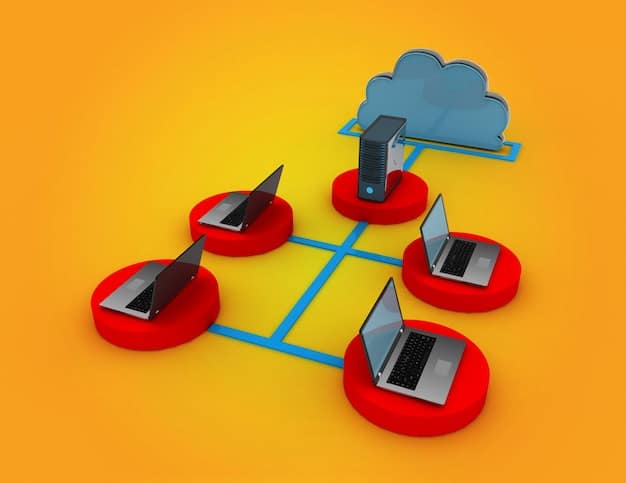Cyber Warfare Threats: Protecting US Businesses from State-Sponsored Attacks

Cyber Warfare Threats from state-sponsored attacks pose a significant risk to US businesses, requiring robust cybersecurity measures, employee training, and proactive threat intelligence to effectively safeguard sensitive data and critical infrastructure.
The digital battlefield is constantly evolving, with cyber warfare threats escalating as state-sponsored actors target US businesses. These attacks can cripple operations, steal intellectual property, and damage reputations. Understanding the landscape and implementing proactive security measures is crucial for survival.
Understanding the Landscape of Cyber Warfare
Cyber warfare has become an increasingly prominent aspect of global conflicts, extending beyond traditional military engagements. It’s essential for US businesses to grasp the current situation to understand potential risks.
State-sponsored cyber attacks are not just theoretical threats; they are a tangible reality. These attacks are often highly sophisticated, well-funded, and persistent, making them particularly dangerous for businesses of all sizes.
The Rise of State-Sponsored Cyber Attacks
The frequency and sophistication of these attacks have increased dramatically in recent years. Nation-states are investing heavily in developing offensive cyber capabilities, employing skilled hackers, and leveraging advanced technologies.
Common Tactics and Techniques
State-sponsored actors typically use a range of tactics, including:
- Spear phishing: Targeted email campaigns designed to steal credentials.
- Malware deployment: Introducing malicious software to disrupt operations or steal data.
- Ransomware attacks: Encrypting critical data and demanding payment for its release.
- Denial-of-service (DoS) attacks: Overwhelming systems with traffic, making them unavailable.

By understanding these tactics, businesses can better prepare their defenses.
In conclusion, recognizing the escalating threat of state-sponsored cyber warfare and understanding the tactics employed by these actors is the first critical step for any US business aiming to protect itself. Proactive measures are essential to mitigate risks and safeguard critical assets.
Identifying Your Vulnerabilities
Before implementing any security measures, US businesses must identify their vulnerabilities. The best way to address issues is through careful analysis based on potential points of exploitations.
A comprehensive risk assessment is crucial. This involves examining all aspects of your organization, from IT infrastructure to employee training, to pinpoint potential weaknesses.
Conducting a Thorough Risk Assessment
Start by identifying your critical assets: data databases, server, and sensitive client information. Then, evaluate the potential threats to these assets, considering both internal and external risks.
Consider these factors during your risk assessment:
- Software vulnerabilities: Outdated software and unpatched systems are prime targets.
- Weak passwords: Easy-to-guess or reused passwords can be easily compromised.
- Lack of employee training: Untrained employees are more likely to fall for phishing scams.
- Inadequate security protocols: Missing or poorly configured security protocols can leave gaps.
Once you’ve identified your vulnerabilities, you can prioritize them based on the potential impact and likelihood of exploitation. This will help you focus your resources on the most critical areas first.

In summary, understanding and addressing vulnerabilities through a thorough risk assessment is the cornerstone of a robust cybersecurity strategy for US businesses. This process ensures that the most critical assets are protected against potential threats.
Strengthening Your Cybersecurity Posture
Once you have a clear understanding of your vulnerabilities, the next step is to strengthen your cybersecurity posture. This involves implementing a range of technical and organizational measures to protect your systems and data.
A multi-layered approach is essential. This means implementing a combination of technologies and practices to create multiple lines of defense.
Implementing a Multi-Layered Security Approach
A strong cybersecurity posture includes robust firewalls, intrusion detection systems (IDS), and intrusion prevention systems (IPS) to block malicious traffic and detect suspicious activity.
Key Strategies for Enhanced Protection
Consider these strategies:
- Endpoint protection: Employing anti-malware software and endpoint detection and response (EDR) solutions.
- Network segmentation: Dividing your network into smaller, isolated segments to limit the impact of a breach.
- Data encryption: Encrypting sensitive data both in transit and at rest to protect it from unauthorized access.
- Regular security audits: Conducting regular audits to identify and address vulnerabilities.
By implementing these strategies, you can significantly reduce your risk of falling victim to cyber warfare attacks.
In summary, strengthening your cybersecurity posture requires a multi-faceted approach that combines advanced technologies, robust security protocols, and continuous monitoring. This proactive stance is essential for defending against sophisticated state-sponsored cyber threats.
Educating and Empowering Your Employees
Employees are often the weakest link in the cybersecurity chain. Educating and empowering them to recognize and respond to threats is critical.
Comprehensive training programs are essential. These programs should cover a range of topics, from recognizing phishing emails to understanding social engineering tactics.
The Importance of Cybersecurity Training Programs
Employees should be trained to identify suspicious emails, links, and attachments. They should also understand the importance of using strong, unique passwords and keeping their software up to date.
Your training should cover:
- Phishing awareness: How to identify and avoid phishing scams.
- Password security: Creating and managing strong passwords.
- Data handling: Protecting sensitive data and complying with privacy regulations.
- Incident reporting: Knowing how to report security incidents.
Regular training and simulations can help reinforce these concepts and keep employees vigilant.
In conclusion, empowering employees with cybersecurity knowledge and training is crucial for building a strong defense against cyber warfare threats. A well-informed workforce can act as a critical line of defense, mitigating risks and protecting sensitive information.
Incident Response and Recovery Planning
Despite your best efforts, a cyber attack may still occur. Having a well-defined incident response and recovery plan is crucial for minimizing damage and restoring operations.
An incident response plan outlines the steps to take in the event of a security breach. This plan should be documented, tested, and regularly updated.
Developing a Robust Incident Response Plan
Your plan should include:
- Designated incident response team: A team of individuals responsible for managing the response.
- Communication protocols: Clear lines of communication for reporting and escalating incidents.
- Containment strategies: Steps to contain the breach and prevent further damage.
- Eradication procedures: Methods for removing malware and restoring affected systems.
Regularly test and refine your plan through tabletop exercises and simulations.
Disaster Recovery and Business Continuity
In addition to incident response, you should have a disaster recovery plan in place to ensure business continuity. This plan should outline how to restore critical systems and data in the event of a major disruption.
In summary, having a comprehensive incident response and recovery plan is essential for minimizing the impact of cyber attacks and ensuring business continuity. Regular testing and updates are crucial to maintaining its effectiveness.
Staying Ahead of Threats: Continuous Monitoring and Threat Intelligence
The cyber threat landscape is constantly evolving so it’s important to stay informed. US businesses need to employ continuous monitoring and actionable threat intelligence.
Continuous monitoring involves actively monitoring your systems and networks for suspicious activity. This can help you detect and respond to threats in real-time.
Implementing Continuous Monitoring Solutions
Tools like Security Information and Event Management (SIEM) systems can aggregate and analyze security logs from various sources, providing a comprehensive view of your security posture.
Leveraging Threat Intelligence
Threat intelligence involves gathering and analyzing information about emerging threats and vulnerabilities. This can help you proactively identify and mitigate risks.
Continuous monitoring should include:
- Real-time threat intelligence feeds: Access to up-to-date information on emerging threats.
- Vulnerability scanning: Regularly scanning your systems for known vulnerabilities.
- Behavioral analysis: Monitoring user and system behavior for anomalies.
By staying informed and proactively addressing threats, you can significantly reduce your risk of falling victim to cyber warfare attacks.
Leveraging threat intelligence is a critical aspect of proactive cybersecurity. It enables businesses to anticipate attacks and fortify their defenses. Staying informed about the ever-changing threat landscape is essential for maintaining a strong security posture.
| Key Point | Brief Description |
|---|---|
| 🛡️ Risk Assessment | Identify critical assets and potential threats. |
| 🔒 Multi-Layered Security | Implement firewalls, IDS/IPS, and endpoint protection. |
| 👨🏫 Employee Training | Educate employees on phishing, passwords, and data handling. |
| 🚨 Incident Response | Prepare a plan for security breaches and data recovery. |
FAQ
State-sponsored cyber attacks aim to steal intellectual property, disrupt critical infrastructure, gather intelligence, or damage a target country’s economy. These attacks are strategic and politically motivated.
Small businesses can protect themselves by implementing basic security measures like firewalls, anti-virus software, employee training, and regular data backups. They should prioritize securing sensitive data.
A “zero-day” vulnerability is a software flaw unknown to the vendor. It’s dangerous because there’s no patch available, making systems highly vulnerable to exploitation by attackers.
Encryption converts data into an unreadable format, protecting it from unauthorized access. It’s essential for securing sensitive information both in transit and when stored on devices or servers.
Businesses should continuously update their cybersecurity measures. This includes patching software, updating security policies, and providing ongoing employee training to adapt to evolving threats.
Conclusion
In conclusion, protecting US businesses from state-sponsored cyber warfare threats requires a proactive, multi-faceted approach. By understanding the landscape, identifying vulnerabilities, strengthening security, educating employees, and staying informed, businesses can significantly reduce their risk and safeguard their critical assets.





